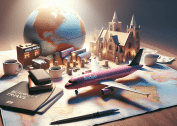Ever wondered what it’s truly like to travel solo? Dive into this practical guide packed with the latest strategies for solo travel planning, cultural immersion, safety tips, and finding affordable, unforgettable destinations. Discover how to shape your own adventure while navigating the evolving world of independent journeys.
Solo Travel Planning: Your Pathway to Freedom
Solo travel offers a powerful sense of independence and self-discovery that group tours can’t always match. Many travelers are increasingly drawn to the freedom that comes with planning their own itineraries. Whether it’s exploring vibrant metropolises or relaxing in quiet countryside villages, the choice is entirely in your hands. Thoughtful solo travel planning helps ensure you get the most out of your journey, from finding high-value destinations to maximizing your time abroad. Make use of reputable resources, such as Lonely Planet or local tourism boards, when drafting your route and choosing accommodations. These guides can alert you to attractions that often get overlooked but provide richer, more personal travel experiences (Source: https://www.lonelyplanet.com/articles/planning-your-first-solo-trip).
Attention to detail—such as transport logistics, travel insurance, and flexible booking options—can greatly enhance overall safety and comfort. Sites like TripAdvisor aggregate user reviews, helping you select places that align with both your budget and personal preferences. Structure your days with room for spontaneous activities or local festivals. By mapping out essentials while leaving space for unexpected discoveries, solo travelers often report a deepened sense of confidence and adaptability. Overall, solo journeys encourage personal growth through every challenge and delight along the way (Source: https://www.tripadvisor.com/TravelersChoice-Destinations-cSolo).
Personalizing your solo travel planning means checking entry requirements, such as visas or vaccination documentation. The U.S. Department of State’s website and equivalent international portals can keep you informed about any evolving advisories. Most successful solo travelers make a habit of researching safety updates, weather patterns, and currency exchange rates before they go. The process not only prevents surprises but also helps travelers stay agile on the road. The key is preparation without rigidity—empowering independent voyagers to explore while keeping worries at bay (Source: https://travel.state.gov/content/travel/en/international-travel/before-you-go.html).
Finding Safe and Affordable Destinations
Choosing the right destinations is a critical aspect of solo travel, especially for those seeking both safety and affordability. Many governments release annual safety rankings and travel advisories that compare global cities and countries according to crime rates, health infrastructure, and natural hazards. Solo travelers often use these resources alongside established rankings like the Global Peace Index to make informed decisions. Many affordable solo travel destinations—such as Portugal, Vietnam, or Costa Rica—make the list for their welcoming atmosphere, low costs, and established backpacker communities. Safety is best balanced with adventure by sticking to well-reviewed accommodations, exploring during daylight, and using trusted transportation methods (Source: https://www.visionofhumanity.org/maps/#/).
Managing your travel budget can be surprisingly straightforward with digital planning tools such as budgeting apps and currency converters. Flexible travel dates often bring substantial airfare savings, especially on lesser-known airlines or by traveling outside peak seasons. It’s also worth exploring public transit and local eateries for both authentic experiences and financial savings. Many experienced travelers recommend minimizing cash and using travel cards or mobile payment systems to reduce risk. These strategies help ensure that solo travel remains affordable, while still allowing for occasional splurges—perhaps a scenic train journey or a guided nature trek (Source: https://creditcards.usnews.com/travel).
The rising popularity of solo travel means that more hostels, guesthouses, and boutique hotels now cater specifically to independent adventurers. These lodgings often feature communal spaces, offering opportunities to connect with like-minded travelers and join small-group tours if desired. Such environments provide both social support and professional guidance for exploring off-the-beaten-path locations. For those focused on safety, services like Hostelworld and Booking.com allow users to filter for female-only dorms, secure lockers, and established reputations. Combining communal living with independent itineraries delivers a compelling balance for solo explorers (Source: https://www.hostelworld.com/).
Cultural Immersion: Deepening Your Travel Experience
Solo travel often opens doors to authentic cultural exchanges. Without the buffer of a group, independent travelers find themselves engaging directly with locals and immersing in daily customs. Cultural immersion deepens one’s understanding of a place, from learning basic language phrases to participating in community workshops or volunteer programs. These experiences let you step “beyond the postcard,” creating moments of genuine connection—perhaps learning to cook traditional dishes or joining street festivals. Many organizations, such as Workaway and WWOOF, connect travelers with volunteer opportunities that enable meaningful exchange (Source: https://www.workaway.info/).
Building cultural awareness starts before departure. Exploring local traditions, etiquette, and taboos ensures respectful and fulfilling interactions. Guides like Culture Crossing and UNESCO’s World Heritage lists provide insights into the art, architecture, and rituals defining each destination. By participating in neighborhood tours, language exchanges, or museum programs, solo travelers often develop friendships that outlast the journey itself. This intentional approach transforms travel from sightseeing into a truly immersive experience, one where learning happens organically at every interaction (Source: https://www.culturecrossing.net/).
Approaching cultural immersion with curiosity and humility yields special highlights. Many solo travelers report serendipitous encounters while navigating markets or riding public transit—unexpected invitations to dinner, shared laughter, or impromptu guides through unfamiliar streets. Documenting these moments in a travel journal or blog helps capture the nuances of cultural discovery for future reflection. This personal storytelling becomes both a treasured souvenir and a source of inspiration for future journeys (Source: https://whc.unesco.org/).
Staying Safe and Connected While Traveling Alone
Safety is a top concern for solo travel, but a few smart habits go a long way. Registering with your country’s embassy or consulate can streamline communication in case of emergencies. Smartphone apps dedicated to travel safety—such as Smart Traveller or Google Maps offline—provide peace of mind, offering instant local emergency numbers and offline navigation. Investing in a reliable portable charger means you’re never out of reach for long. Families often appreciate having regular check-ins established, which can be as simple as a daily WhatsApp message. Proactive communication is a core part of a successful solo journey (Source: https://travel.state.gov/content/travel/en/international-travel/emergencies.html).
Staying healthy and alert is equally important, especially when circumstances change rapidly. Research reputable travel clinics or hospitals along your route in advance. Pack a basic first-aid kit, prescription medications, and documentation for any allergies or conditions. Most seasoned solo travelers recommend learning how to ask for help in the local language and memorizing essential phrases for navigating transit systems. Carrying a doorstop alarm or a personal safety whistle can deter petty theft and provide reassurance at accommodations. While solo journeys require extra vigilance, they seldom feel lonely thanks to these forward-thinking practices (Source: https://www.cdc.gov/travel/page/travelers-health.html).
Modern technology makes solo adventuring easier and more connected than ever. Cloud-based backups for essential documents and travel insurance cards mean that replacements are always within reach, even if physical copies are lost. Private VPN services protect digital privacy when logging onto public Wi-Fi or booking services online. In addition to practical tools, many solo travelers find emotional support by joining travel forums or social media groups centered around independent travel. These spaces foster both sharing experiences and troubleshooting challenges. In this way, solo travel often leads to unexpected friendships and ongoing connections around the world (Source: https://www.nomadicmatt.com/travel-blogs/solo-travel-safety/).
Unique Experiences for Independent Travelers
Solo journeys can lead to some of the world’s most unforgettable moments. Many travelers report that venturing alone increases their openness to new adventures—whether it’s summiting a volcanic peak or stumbling upon impromptu night markets. Choosing experience-rich activities, like taking a scenic train route or attending a wellness retreat, can ignite a sense of wonder and accomplishment. Some find immense satisfaction in “slow travel”—spending weeks in a single location to truly understand its rhythms. Uniqueness comes not just from where you go, but how deeply you engage with your surroundings (Source: https://www.intrepidtravel.com/adventures/solo-travel-guide/).
Well-planned solo adventures make it easier to pivot between relaxation and exploration as mood and weather dictate. For many, the real joy lies in those spontaneous choices: booking a local cooking class found on a bulletin board, listening to live music in a tucked-away cafe, or hiking to a remote temple at sunrise. Small groups or day tours can add structure while still letting you enjoy the freedom that defines solo travel. Apps like Meetup host local interest groups in most major cities, allowing solo adventurers to connect with locals over shared interests (Source: https://www.meetup.com/).
Documenting your unique travel experiences—whether through photography, social media, or personal writing—deepens appreciation for the journey and creates a record for reflection. Many solo travelers discover lifelong hobbies or creative outlets this way. Capturing memories while remaining present allows each adventure to resonate for years. These stories often inspire others to set out on solo journeys of their own, reinforcing a worldwide community of independent explorers (Source: https://www.nationalgeographic.com/travel/article/solo-travel-trend).
Tips for Sustaining Your Travel Confidence
Confidence grows with every successful challenge navigated on the road. Begin with smaller, local excursions to build your decision-making skills before attempting long-haul or multi-country trips. Practicing basic phrases in new languages or navigating unfamiliar transit systems are perfect opportunities to stretch comfort zones. Take each new experience as a learning opportunity, knowing that small setbacks can build lasting resilience. Even seasoned solo travelers admit to occasional nerves—what matters is a willingness to adapt (Source: https://www.roughguides.com/gallery/tips-for-solo-travel/).
Balancing ambition with self-care creates the most sustainable travel experiences. Long-term travelers often rotate between active periods and downtime, acknowledging the need for rest during extended journeys. Mindfulness practices—such as journaling, meditation, or simple walks—are excellent for staying grounded and present. Seasoned adventurers recommend setting manageable daily goals and expressing gratitude for each new experience. These habits bolster emotional well-being, helping you stay positive and connected even in the face of uncertainty (Source: https://www.psychologytoday.com/us/blog/the-intrusive-thoughts-of-wandering-minds/201902/how-solo-travel-changes-your-life).
Reflect regularly on milestones reached and lessons learned. Solo travel journals or photo blogs allow you to track personal growth and celebrate the courage it takes to embark on your own. By sharing stories and tips online or in person, you’ll join a growing community dedicated to supporting and uplifting independent travelers. These connections fuel both future adventures and lifelong friendships, ensuring that your solo journeys never truly stand alone (Source: https://thirdeyetraveller.com/solo-travel-confidence-tips/).
References
1. Lonely Planet. (n.d.). Planning your first solo trip. Retrieved from https://www.lonelyplanet.com/articles/planning-your-first-solo-trip
2. Vision of Humanity. (n.d.). Global Peace Index – Travel safety rankings. Retrieved from https://www.visionofhumanity.org/maps/#/
3. U.S. Department of State. (n.d.). Before you go. Retrieved from https://travel.state.gov/content/travel/en/international-travel/before-you-go.html
4. Workaway. (n.d.). Volunteer opportunities for cultural immersion. Retrieved from https://www.workaway.info/
5. CDC. (n.d.). Travelers’ health resources. Retrieved from https://www.cdc.gov/travel/page/travelers-health.html
6. National Geographic. (n.d.). The solo travel trend is growing, and here’s why. Retrieved from https://www.nationalgeographic.com/travel/article/solo-travel-trend









